30 of New Zealand’s most stunning natural wonders

From the seismic, steaming landscapes of North Island to the uplifting vistas of the South Island, magical places abound in New Zealand. Its spellbinding scenery has starred in many a movie, famously doubling for Middle Earth in The Lord of the Rings. The forces of nature are perhaps more apparent in the Land of the Long White Cloud than anywhere else on Earth, creating technicoloured geothermal lakes, smoking volcanoes, mighty glaciers and jaw-dropping fiords.

The awe-inspiring proportions of Milford Sound are difficult to grasp. Its sheer mountainsides, ravines and precipitous waterfalls dwarf the cruise liners that come to visit this watery wonderland at the edge of the Southern Alps. Novelist Rudyard Kipling was so struck by the fiords, he described them as the eighth wonder of the world, and no trip to New Zealand’s South Island would be complete without taking a tour here. The fiord is best seen by boat, or scenic flights offer a bird's-eye view.

Flowing thousands of metres down from mountain peaks all the way to the ocean, the sheer scale of Franz Josef Glacier isn’t fully apparent until you come face-to-face with its base. The temperate New Zealand climate, low altitude and proximity to the town of the same name make this frozen landscape of compacted blue ice easily accessible too – you can hike around its base and come within 2,460 feet (750m) of its terminal face, opt for a guided ice walk or sign up for some aerial sightseeing with a helicopter tour.

Abel Tasman National Park is a lush coastal paradise near the top of South Island, indented with platinum bays and turquoise waters, with quirky geologic features like Split Apple Rock – which scientists believe was split by a natural phenomenon known as ‘ice wedging’ during an ice age more than 120 million years ago – sited just offshore. The park's bounty of unspoilt beaches include Torrent Bay and Kaiteriteri beach, voted one of the top five in the world. Kayaking tours are a popular way to appreciate the area’s immense scenic beauty, or to explore on foot, follow the Abel Tasman track along the coast.

The stunning aquamarine Blue Pools in Unesco-listed Mount Aspiring National Park are one of South Island’s scenic masterpieces. Sited at the point where the glacial Makarora River flows into Lake Wanaka, you can follow the beautiful forest trail of Blue Pools Track at Haast Pass to a suspension bridge crossing the pools, where the clear, cool water tempts swimmers, especially on sunny days.
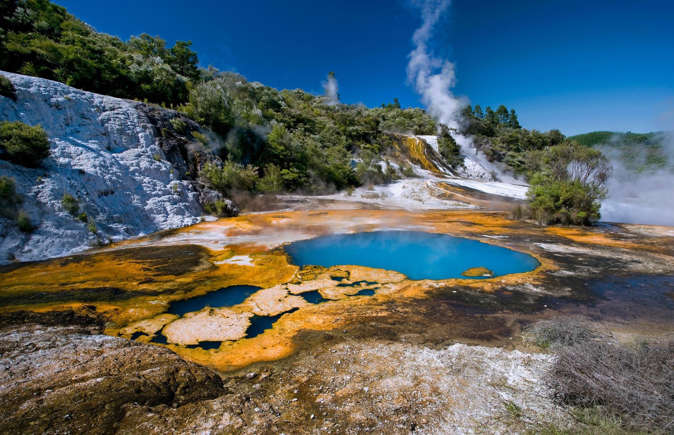
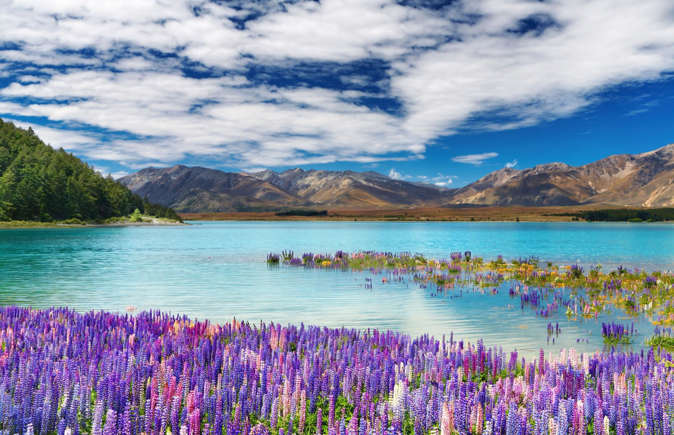

Part of a Unesco-listed geopark, New Zealand’s coast around North Otago is strewn with weird and wonderful geologic marvels that are well worth a stop at for a photo opp. Aptly-named for their smooth, grey humps and curves, Elephant Rocks appear like a herd of fossilised elephants grazing on the green hillsides, close to the Island Cliff-Duntroon road. The strange, weathered stones even formed the backdrop for scenes in the first The Chronicles of Narnia film.

Another of New Zealand’s most spectacular and accessible icy wonders, the 13km-long Fox Glacier slopes down from 8,530 feet (2,600m) high in the Southern Alps into the ocean, close to the Franz Josef Glacier on the country’s west coast. At Fox Glacier village, join guided tours and stay in accommodation that provides easy access to an Ice Age wilderness of frozen valleys, tunnels and caves surrounded by forest. Ambitious explorers can even arrange a heli-hike to the peak of the glacier, or take in the magnificent view from the ground at Cook Flat Road, en route to Lake Matheson.
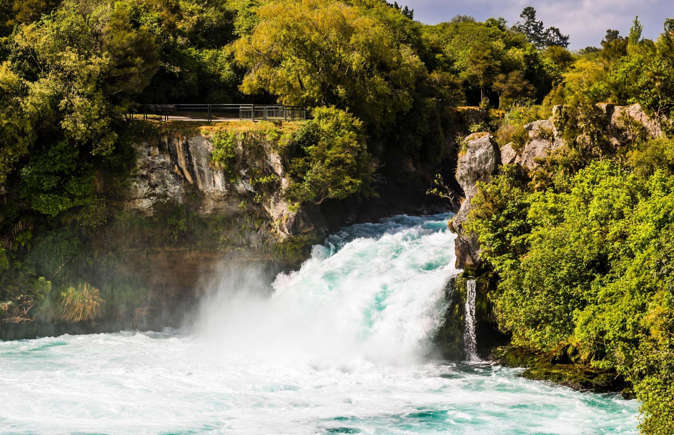



These huge, bulbous anomalies scattering the sand of Koekohe Beach, between the towns of Moeraki and Hampden, add a different dimension to South Island’s scenic North Otago coast. Appearing like giant cannonballs up to 6.5 feet (2m) high, the geologic wonders look as though they were carved by human hands, but in fact they are made of calcified rock concreted together 65 million years ago and slowly released from the soft seabed by coastal erosion. Similar Koutu Boulders can be found around Hokianga Harbour on North Island.

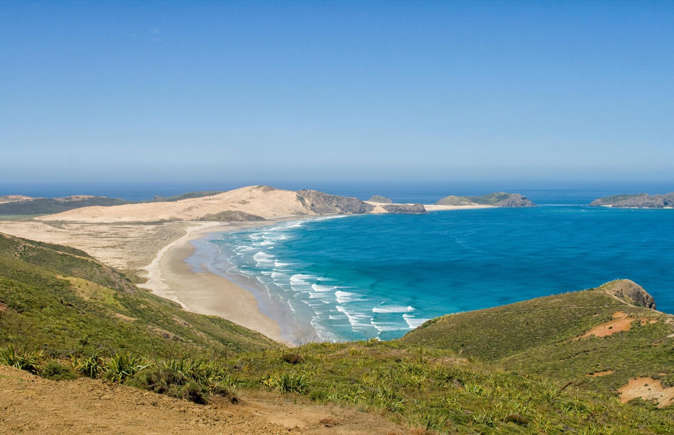
The iconic Ninety Mile Beach at the far northern tip of North Island is a wide band of seemingly endless golden sand, which, contrary to its name, is in fact 55 miles (89km) long. The beach is used as an official road at low tide, with buses offering tours along the beach. Boasting one of the best left-hand surf breaks in the world, the beach is a haven for surfers, while beach activities also include bodyboarding down the sand dunes. The beach is also renowned for its stunning sunsets.
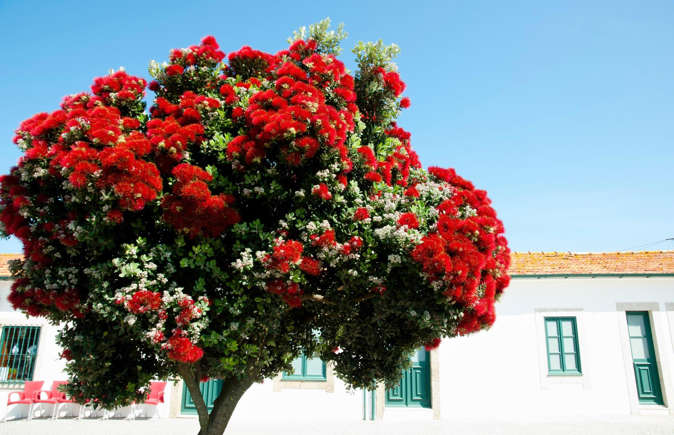


The Rotorua area is jam-packed with geologic marvels, but Pohutu Geyser towers above the rest – suddenly erupting boiling water 98 feet (30m) into the air at least once every hour to the delight of onlookers. The largest active geyser in the southern hemisphere, Pohutu is part of Te Puia’s Te Whakarewarewa Geothermal Valley, full of bubbling pools and coursing elemental energy. Look out for the nearby Prince of Wales Feathers geyser, which always shoots water just before its bigger neighbour erupts.


A lost world flanked by mountains and carved out by glaciers in Fiordland National Park, Sinbad Gully’s rivers and forests lay hidden for centuries. Hemmed in by the famous Mitre Peak on one side and Llawrenny Peaks on the other, the gully opens out into the jaw-dropping fiords of Milford Sound. Cut off from the world, nature has gone her own way here, creating strange species found nowhere else. The gully was the last mainland stronghold for the critically endangered Kakapo (pictured), a huge, cuddly, flightless parrot now only found on Codfish Island.

The South’s answer to the Northern Lights, the Aurora Australis is less well-known but its lime green and rosy light show is just as spectacular. One of the top places to view the curtain of electro-charged lights is around Queenstown on New Zealand’s South Island, but the closer you can get to the South Pole, the better. Most Southern Lights shows occur during the Southern Hemisphere’s autumn and winter months, from March to September.



This primordial world of towering ancient trees on the northern tip of New Zealand is the largest remaining tract of native forest in Northland. It's home to Tane Mahuta – the Lord of the Forest – a 2,000-year-old sacred kauri tree that measures 14 feet (4.4m) around its trunk and almost 59 feet (18m) up to its first branch. That's young compared to another giant kauri tree found here: Te Matua Ngahere, meaning Father of the Forest, is estimated to be between 2,500 and 3,000 years old.

Te Waikoropupu Springs contain some of the clearest water ever measured and they are the largest cold freshwater springs in the southern hemisphere, releasing a staggering 14,000 litres of water per second. Close to the town of Tanaka, a 1km-loop trail threads through forest and across streams to a platform suspended above the still, crystalline water, where you gaze down into a blue-tinged underwater forest. Please note that swimming is forbidden here due to the springs’ spiritual significance to the Maori people.



A network of subterranean caves and rivers snakes beneath Waitomo’s verdant hills in New Zealand’s north-east, harbouring magical, glowing caverns. Tours by boat and on foot take visitors deep underground to witness the phenomena, with thousands of glow worms lighting the cave ceiling like a sea of white-blue stars. Above ground, the area has more not-to-be-missed natural marvels, including the beautiful Marokopa Falls and limestone Mangapohue Natural Bridge.
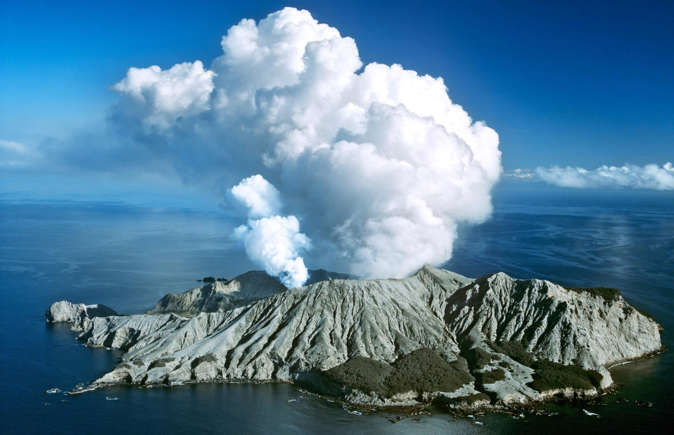

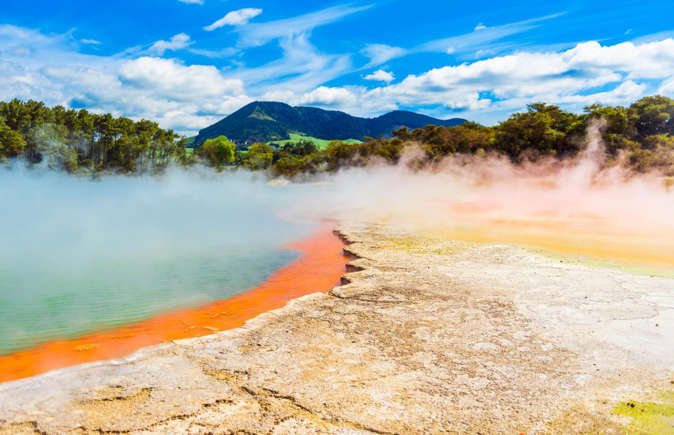
This geothermal wonderland powered by Earth’s core was dubbed ‘Hellsgate’ by famous playwright George Bernard Shaw, due to its steaming landscape of colourful sulphurous springs. The highlight – Champagne Pool – appears like a giant artist’s palette of electric-blue, orange and yellow. Surrounded by bubbling mud cauldrons, neon-green ponds and spraying pools, visitors can lose themselves in the surreal scene by following the secure tracks around the site. Arrive before 10:15am to catch Lady Knox Geyser’s dramatic daily eruption.
'Wonderful World' 카테고리의 다른 글
| 8 Shearwater Rise, Rothesay Bay, North Shore City, Auckland (0) | 2024.02.22 |
|---|---|
| 뚫어 논 듯한 바위가 멋집니다 (0) | 2024.02.21 |
| 봄 날씨 하루만에 폭설… 눈 덮힌 백두대간 절경 (0) | 2024.02.17 |
| Castle Hill –Canterbury, New Zealand (0) | 2024.02.16 |
| 전남 고흥 팔영산(八影山) (0) | 2024.02.15 |